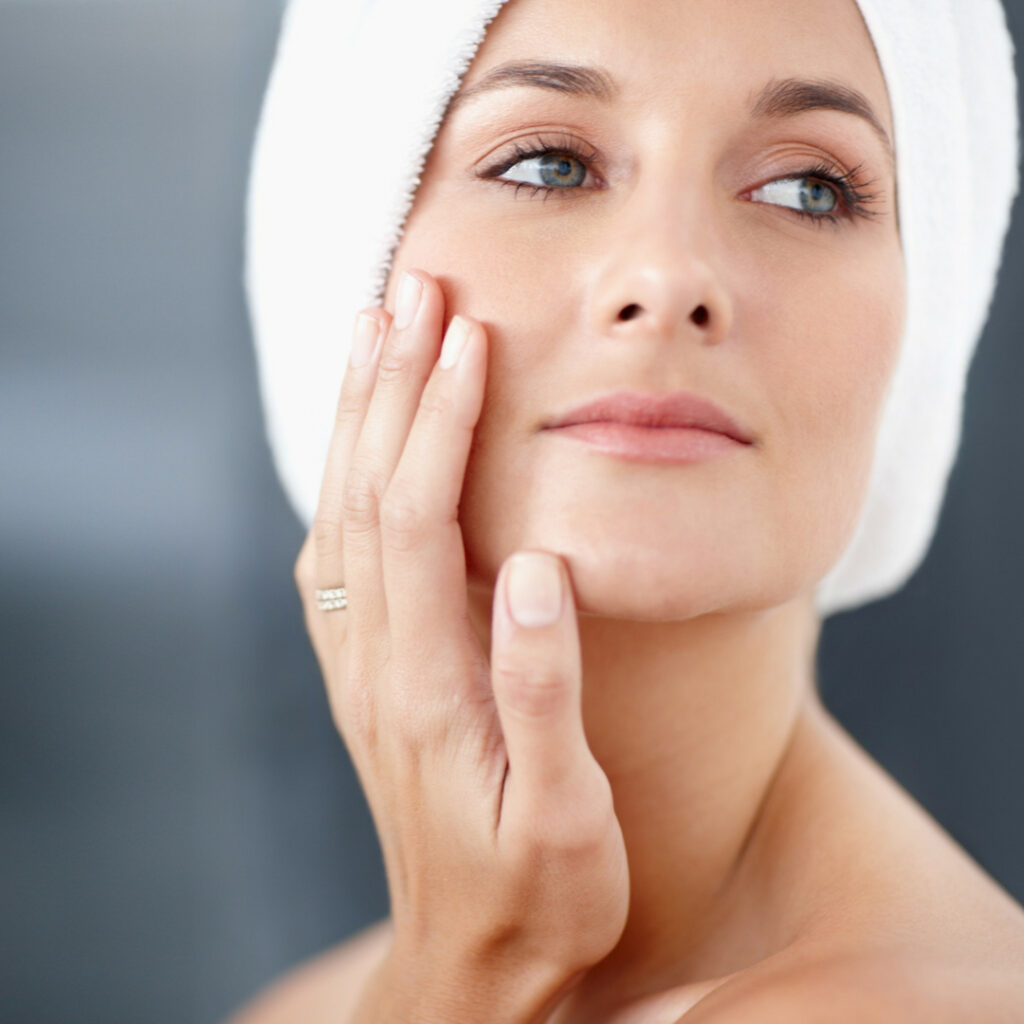To clearly discover your skin type, it’s crucial to understand that your skin is as unique as your blueprint.
You are born with your skin type, it is in your genetic makeup but since the skin is an organ in constant evolution, it responds to changes in its surroundings, lifestyle and age factors which have a direct effect on the skin causing it to get out of balance and more prone to ageing.
Learning and understanding your skin type is very important because it will not only help you detect and adapt to the skin changes but also select the best treatment options and correct skincare.
Many skin problems arise from using the wrong products ending in skin imbalances and other skin issues like inflammation and breakouts.
I know, we are bombarded by the phrase “perfect skin” everywhere and although it sounds extremely appealing, the truth is that most people will have some concerns about their skin, specially as time passes by. But working with people daily for many years has allowed me to see that most of them look for the same goal not perfect but “healthy-looking skin.”
Skin types are determined by the amount and distribution of sebum the skin produces which influences texture, pore size and overall behavior of the skin. Too much oil can end up in acne or too little sebum can result in irritation and discomfort of the skin.
These elemental factors impact the skin dividing it into 4 main categories:
- Normal
- Dry
- Oily
- Combination.
However; as a professional, I believe that in order to have a more accurate analysis, other crucial factors should also be considered:
- SKIN COLOR based on the Fitzpatrick scale which measures 6 skin types ranging from very white skin which burns very easily and never tans to the darkest skin which never burns and other shades in between. This helps you understand how vulnerable your skin is to sun damage.
- SKIN DENSITY taking in consideration how thick or thin the skin is in function of the depth of the three layers of your skin will give you a good idea of how delicate or resilient your skin is.
- LAXITY how “firm” or “saggy” the skin is reflects its levels of elasticity caused by break down of collagen and elastin in the underlying structure. This factor helps to determine how the skin is aging at a deeper level.
- SKIN FRAGILITY how the skin will react and tolerate different treatments and skincare products helps you determine how sensitive your skin is.
Without any further due, let’s get into the details of each skin type:
NORMAL SKIN (well-balanced skin) meaning not too oily or too dry.
Sebum is distributed evenly throughout all facial areas. The complexion looks healthy with refined pores, smooth texture, even tone and no blemishes.
In many years of treating skin, I have come across this skin type may be four or five times, it is extremely rare to have skin that is completely balanced because as I discussed earlier, we are surrounded by internal and external elements that constantly affect the skin.
But if you have the blessing of having normal skin, lighter lotions and serums are ideal to maintain it and fight the signs of aging. Good ingredients are always beneficial even if your skin is in good health.
DRY SKIN (produces less sebum than normal skin) the medical term for dry skin is “Xerosis”.
It lacks essential lipids for proper barrier function like ceramides, cholesterol and fatty acids along with deficiencies in urea, amino acids and lactic acid; Natural moisturizing factors (NMFs) necessary to maintain normal moisture levels in the skin.
This skin type usually presents very small pore size, tends to lack radiance and has an overall feeling of tightness. Often, it has more visible lines, less elasticity and could also experience flaking.
Moisture is vital to the care of dry skin. Use lotions and rich creams to nourish your skin cells and supply the skin what it lacks. One very important point is to identify if your skin is dry because of lack of lipids or water or both. There is a big difference between moisturization and dehydration.
Replenishing what the skin lacks will improve skin balance and restore its healthy state.
OILY SKIN (produces more sebum than normal skin) abundant sebum production known as “seborrhea”, pores appear larger and the skin looks shiny and has a thicker felling.
Oily skin tends to be more prone to blackheads and whiteheads and to various forms of acne.
Cleansing the face twice a day and avoiding heavy creams is recommended to minimize the appearance oily skin. Look for lighter texture products like serums, gels and oil-free sunscreens to prevent over saturation of oil within the follicle which can become a culprit for breakouts.
COMBINATION SKIN (presents a mix of skin types) normally oilier on the T Zone located across the forehead and on the nose and chin areas.
Enlarged pores are more visible in this region while the cheeks present characteristics of normal or dry skin.
This skin type is very common, and it is tricky to treat because you are dealing with different skin types at the same time. Blemishes can be present on oily areas and excessive dryness on the others.
People with combination skin should consider using different products for different areas of the face to keep the skin balanced. To keep it simple, a good idea is to opt for products that are not too heavy or too light.
Lotions make a great choice for combination skin.
Serums can be layered providing fantastic results also. Special attention must be placed on the cleanser and toner. Select cleansers that are not too rich or too harsh, preferably pH balanced, and be careful with toners containing alcohol, this can end up causing excessive dryness on those areas that are already dry.
SENSITIVE SKIN
Although not formally considered a skin type but more of a skin condition. I feel that sensitive skin needs its own description.
Many people suffer from this condition. It is skin that is over reactive, fragile and delicate and gets irritated very easily. You can have any skin type mentioned above and also have sensitive skin.
Having very sensitive skin myself, my personal experience is that it is a very difficult condition to have, many factors are involved, and it is such an extensive topic that deserves an entire article but for now I can tell you that “less is more” when treating this condition and ingredients do have a huge impact in this case.
Specially restoring healthy lipids like ceramides and fatty acids and staying away from skin sensitizers like fragrances, colorants, certain essential oils (not all oils are the same, there are some that can be very sensitizing for the skin), harmful chemicals etc.
With the correct ingredients and treatment, you can improve sensitive skin and make it more resilient. I compare it to a roller coaster ride, it constantly has its ups and downs, but again when you know what you are dealing with and what to use to improve it, you can accomplish very positive changes.
FOR ALL SKIN TYPES
SUN CARE IS A MUST FOR HEALTHY SKIN
Ultraviolet radiation harms the skin causing:
Sunburn, breaking down collagen and elastin, damaging healthy cells and causing skin cancer.
It’s important to remember that all skin types should conscientiously apply sunscreen daily. Even if the weather is cloudy or rainy.
Protecting your skin from incidental sun exposure is vital to prevent skin cancer and photo ageing. Look for sunscreen formulas that suit your skin type.
Most dermatologists recommend using an SPF of 30 or higher to defend your skin and avoid premature ageing.
It is key to note that no sunscreen can block up to 100% of UV rays; therefore, it is essential to apply it in the correct amount and to reapply regularly.
Balanced skin is the healthiest and yes, it’s not easy to achieve but with the right knowledge you can manage what suits your skin best to bring it as close as possible to a balanced healthy state.
Thank you very much for being here.
Until next time.
Dora Salazar
Medical Aesthetician




